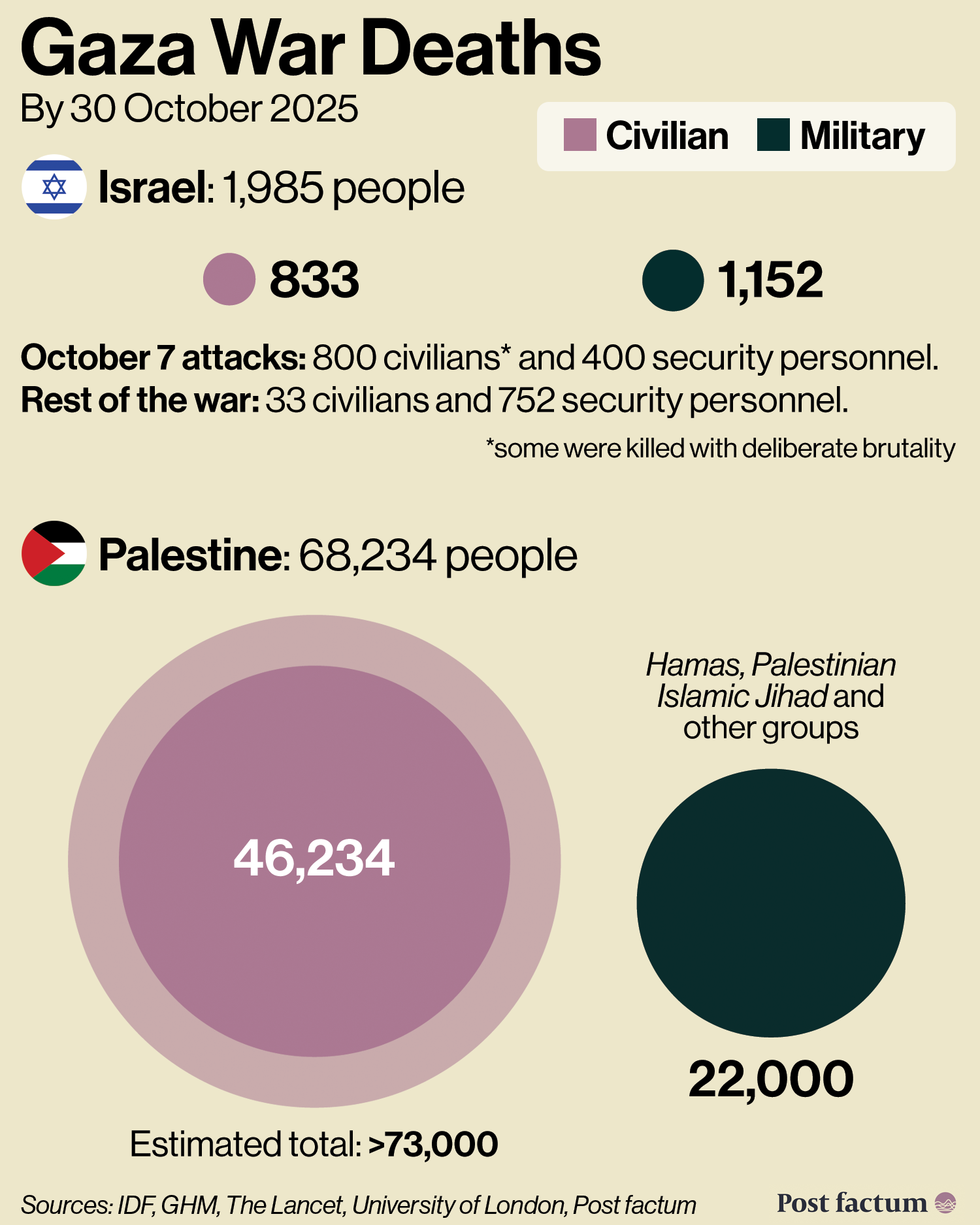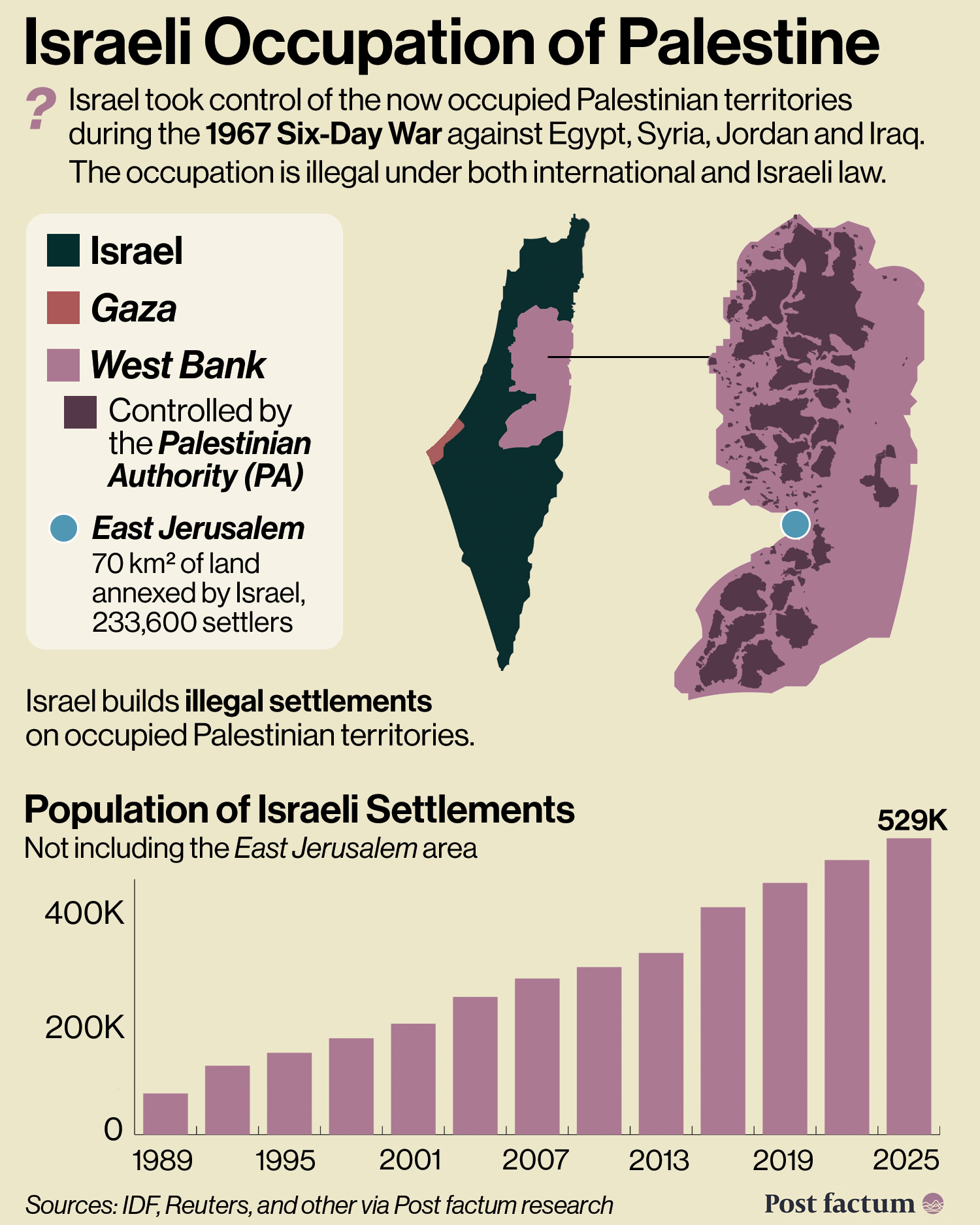GAZA War, analysed
October 30, 2025
Is the death toll reliable?
Is Israel committing war crimes?
See section 2.
Modern-day Arab-Israeli conflict started during the time of British control over Palestine.
Palestine was ruled by the Ottoman (Turkish) Empire for 400 years until its defeat in World War I.
Since then, the arrival of Zionist settlers in Palestine created an ethnic conflict in the region.
Zionism: a movement for a Jewish state in Palestine started in 19th-century Europe.
At the time, antisemitism (discrimination against Jews) was increasing across Europe.
Jewish culture originates from Palestine.
1917: Britain officially supported the idea of forming a “national home for Jewish people” in Palestine, while upholding the rights of “existing communities”.
Growing opposition to Jews moving into Palestine escalated into an armed conflict between Arabs, Jews and the British.
The Holocaust: in 1941-45 around 6 million European Jews were killed in a genocide by Nazi Germany and its allies.
1947: United Nations proposed dividing Palestine into a Jewish state and an Arab state. A civil war started.
1948: Israel was officially formed as a country.
Over decades, a conflict between Israel and its Arab neighbours (like Jordan, Syria and Egypt) included multiple wars with tens of thousands killed.
By 2023:
Israel mostly normalised relations with Arab countries like Egypt or Saudi Arabia.
Israel is in a conflict with Iran, which supports anti-Israel groups like Hamas.
The conflict focuses on regional power and the Israeli occupation of Palestine.
Hamas is an Islamist political and militant group that wants to establish a religious Arab state in Palestine.
On 7 October 2023, Hamas led a large-scale terror attack on Israel; it became the deadliest day in the country’s history.
The attack killed around 400 members of Israeli security forces and around 800 civilians, including children and women, many of whom were killed with deliberate brutality.
Israeli intelligence services had knowledge of the planned attack but saw it as unlikely.
Around 251 people were taken hostage by Hamas and its allied groups.
The militants’ actions are war crimes and crimes against humanity under international law, despite groups like Hamas not being countries.
In response to the attack, Israel started a large-scale military campaign in Gaza to (1) free the hostages and (2) destroy the threats to Israel.
Israel’s bombings and ground invasion resulted in over 68,000 Palestinian deaths (by 30 October 2025).
This included around 12,000 children under the age of 13, and over 9,000 women.
Over 170,000 people have been injured, including thousands of children who received life-changing injuries.
Is the data on Palestinian deaths in Gaza reliable?
Yes. The data is an accurate representation of confirmed deaths.
The data is criticised due to Gaza Health Ministry being controlled by Hamas.
However, its data from previous Israel-Hamas fighting proved to be accurate and the data collection methods are reliable.
It is estimated that the real death toll is 40% higher due to:
Bodies remaining under the rubble
Indirect deaths such as from famine
Bodies not reported; and other factors
Hamas’ actions at times put civilians in danger, such as by:
Putting rocket firing positions or strategic objects close to civilian infrastructure, knowing Israel will target them.
Using civilian infrastructure and transport (such as hospitals and ambulances) for military purposes.
Asking residents to ignore Israel’s “orders” to relocate from specific areas.
According to Israel, it killed 22,000 militants by August 2025, including most Hamas leaders. At the time, the official death toll in Gaza was 62,000.
Hamas recruited 15,000 fighters since the start of the war. Israel estimates it now has 20,000 active fighters, down from 30,000 before the war.
This does not include militants from the Palestinian Islamic Jihad, which is about one quarter the size of Hamas.
Hamas is estimated to still have hundreds of rockets, down from 10,000 before the war.
Israel claims that 75% of Hamas’ underground tunnels remain but the most important ones are destroyed.
Gaza War is part of a broader Iran-Israel conflict. Israel defeated the Iran-backed Hezbollah group in Lebanon during the conflict.
Both Israel and the US launched airstrikes against Iran’s nuclear facilities.
Israel and Iran fought a 12-day war. We cover this further in an edition of News Breakdown, our member-exclusive newsletter that revisits the biggest geopolitical events of the past year.
Is Israel committing war crimes in Gaza?
Yes. Israel has been breaking international law, as well as committing war crimes and crimes against humanity in Gaza.
Collective punishment: a key requirement of humanitarian law is that states separate civilians from soldiers (combatants). It is forbidden to use measures like cutting off food, fuel or water as a weapon of war.
Proportionality: humanitarian law forbids any preventable civilian damage that is “disproportionate to the military advantage expected”. In many cases, Israeli forces did not reasonably minimise civilian losses.
Israeli officials generally agree that there are civilian deaths, at the ratio of 2 civilians to 1 militant killed.
They suggest that this represents a careful approach, and that the losses are “average” for urban warfare.
We analyse these claims:
Civilian casualty ratio
Israeli claim of 22,000 militants killed is generally reliable. A leaked database also indicates around 10,000 have been identified by name.
Palestinian claim of 68,000 deaths, civilian and combatant, is reliable, and likely a 40% undercount.
Therefore, the civilian casualty ratio is likely between 2:1 and 4:1, or between 66% and 75%.
Is the civilian casualty ratio “average”?
No. The share of civilian casualties during the Gaza war is above average, and misrepresentation of the data is causing confusion.
While the 66% figure claimed by Israel is generally correct, it is incorrectly compared to other conflicts with high civilian casualties.
Vietnam War (46%): significantly lower, counts the deaths from fighting between North and South Vietnam, including mass killings by both sides, as well as the United States.
Korean War (74%): comparable ratio, counts the fighting between North and South Korea, including mass civilian killings by both sides, the use of napalm, and more.
Yugoslav Wars (54%): includes the genocide of Bosnians.
Gulf War (87%): counts over 100,000 Iraqi rebels killed by the Iraqi dictator after the war, while the US and its allies killed around 4,000 civilians.
Iraq War (67%): a comparable case. US and allies are only responsible for 17-37% of these civilian casualties, with the rest attributed to crime and other causes.
In other comparable conflicts the civilian casualty ratio were lower, such as in Syria or Afghanistan (both 28%).
Another figure quoted: 69% share of civilian casualties for explosive weapon attacks targeting soldiers in urban setting (globally).
However, 50% of the incidents analysed for this study are terror attacks using improvised bombs, not careful military actions.
Most of the civilian casualties in Gaza are attributed to Israeli operations. No other major causes of civilian deaths are reported.
This case is unique because Gaza is under a blockade, making it impossible for most civilians to leave.
Some Israeli political and military leaders have made statements that show anti-Palestinian hatred and calls for collective punishment of Palestinians in Gaza for terror attacks on Israel.
However, this may not be sufficient for the International Court of Justice to find Israel’s actions to be a genocide:
Israel has procedures aimed at lowering civilian casualties even if they are not always effective.
Israel has legal military targets in Gaza in response to October 7 attacks.
Hamas put civilians in danger on some occasions, as discussed above.
Ceasefire deal
On 8 October 2025, Donald Trump announced the signing of a deal between Israel and Hamas:
Ceasefire: stop any fighting.
Exchange remaining hostages for 250 Palestinians serving life sentences in Israel and 1,700 people arrested by Israel in Gaza.
Move the Israeli army out from half of the territory of Gaza, with plans for more.
Increase the flow of humanitarian aid into Gaza and ensure its safety.
At the time of writing, the ceasefire holds but breaches have already happened.
Israel hit individual targets in the first weeks of the ceasefire for suspected breaches of the ceasefire.
On October 27-28 Israel carried out a wave of airstrikes in response to an Israeli soldier being killed in Gaza. 104 Palestinians died in the strikes.
Since the ceasefire, Hamas killed at least 33 Palestinians for challenging the group or collaborating with Israel.
During the 2 years of the Gaza War, a number of new militant groups were formed in opposition to Hamas.
Most of them receive support from Israel which wants to create alternatives to Hamas and destabilise it.
Popular Forces is the largest such group that has multiple semi-independent sub-groups controlling around 3,000 fighters.
Clans of Gaza (Doghmosh, al-Majayda) also represent a political force in the region, some have ties to the Palestinian Authority or international terrorist groups.
Change in public opinion
Israel, Hamas, Iran and other actors engaged in information warfare over the Gaza War.
Globally, 62% of people now have negative views of Israel, up from about 50% before the war in Gaza.
In the US, the country with most favourable views on Israel, it lost 8% of public support: 10% among Democrat voters and 6% among Republican voters.
This was everything we could fit in the report! It included the key data and some information inspired by the questions from our Founding Members. Let us know what we missed, or got wrong.
Author Anton Kutuzov
More below:
Join the discussion:
Thank you for reading!
Please become a Founding Member to support our independence and get perks - vote on future topics, join our research and receive the weekly special:
NEWS BREAKDOWN
Geopolitics of the past year, revisited
News Breakdown:
US Strikes on Iran’s Nuclear Sites
B-2 Stealth Bomber, Bunker Busters, Israel-Iran 12-Day War





